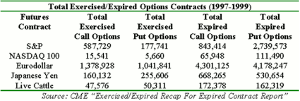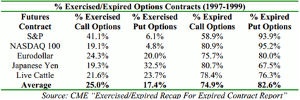A report created by Dr. John Summa sheds some light on the subject of who actually wins more often in options, notes Joshua Belanger of OptionSizzle.com.
One of the first things many new options traders are taught is that more than 60% of all options expire worthless. This statistic, which never had hard research behind it, is usually meant to instill a sense of caution in new and versed traders. Understanding this statistic can help you understand the importance of trade timing on entries and exits. The strategies of new traders tend to focus on long positions and buying options. They often fail to capture the profitable opportunities available using other strategies that involve being an option seller, or short an option, to collect premium.
Being an option seller is somewhat different than shorting a stock. When shorting a stock, you expect shares to move lower and only profit if that happens. When selling an option. there are a number of ways to make a profit. You could sell a call against stock to collect premium, sell a put to collect premium with the intent to own shares of the underlying at a discount if prices do drop lower, or just sell a credit spread looking for prices to hold a level because you are not sure of direction.
I came across a report created by Dr. John Summa, which sheds some light on the subject of who actually wins more often in options. Is it the buyer or the seller of options? Despite the report and research being dated 13 years, I still find the information very relevant and informative to option traders today.
In his study, Dr. Summa finds that time and time again, regardless of market direction, the sellers of options have the advantage over the buyers. Think of it like this; if more than 60% of options expire worthless, and less than 40% of options expire with some value, then don't you think you would rather be on the sell side of the equation?
It is important to note that in his study, Dr. Summa is referring to the ratio of options held to expiration that expire worthless. He does not include all the options contracts that are closed for a lower price than they were opened. The 60% figure is the number I first learned when I began trading. Over the years, I have seen statistics and articles citing that the percentage of options that expire worthless can run up to an astronomical 90%, which is hard to believe. It is hard to know exactly how many options contracts make money for the seller because so many are closed for a profit before the expiration date.
Many traders, new and experienced alike, never consider the fact that time decay can work to their advantage. Whether they are bullish or bearish makes no difference. These traders choose to trade long, on the buy side, and must work hard to overcome many hurdles including time decay and priced-in moves. In order to profit, these traders must utilize strict money management systems and a disciplined approach to trading.
Options writers, another name for options sellers, must also use money management and position sizing to protect themselves and their accounts. Sellers, on the other hand, do not have to overcome time, the price movement of the underlying, or volatility. Option sellers can use those hurdles to their advantage and ride them to profits on a weekly or monthly basis.
NEXT PAGE: Selling Options Is Better
|pagebreak|Dr. Summa's study shows that over time, three of every four options that were traded on the Chicago Mercantile Exchange and held to expiration expired worthless. This means that sellers come out ahead of buyers 75% of the time. An in-depth look at different portions of the study set showed that, depending on market trend, 90% or more of calls or puts expired worthless in a given year. Look at the put statistics for the S&P and the Nasdaq. During the study period, the markets were rallying and over 90% of all puts held until expiration expired worthless. What this means is that during a bull market selling puts can be as close to a sure thing in trading as it gets. The reverse is true in a bear market.
The study is based on data collected from the CME over the course of three years from 1997-1999 and spans five distinct bull or bear markets. In the study, the relationship of buyers versus sellers is based on options held all the way until expiration. It clearly shows that in the end, sellers always have the advantage over buyers. The data is based on the relationship of expired worthless options to the number of exercised options, regardless of profit.
Over the course of the three year period, the average number of options contracts held to expiration that expired worthless was 76.5% of the total options volume for the five CME markets studied. The low was 75.8% and the high was 77.5%, creating a very narrow range and suggesting that the number is fairly consistent over time regardless of market trend.
When broken down into the component markets, the underlying trend of sellers outpacing buyers is seen again. In that time, the percentage of expired worthless options for S&P futures was over 80%, a staggering figure. In each of the markets studied, the number of options that expired worthless is much higher than the number that expire in-the-money. The underlying S&P market trend was bullish at the time, giving call buyers an added advantage over the sellers, although still not enough to overcome the sell-side bias. During that time, 59% of S&P calls expired worthless while only 41% expired in-the-money.
Further, we can see that in each market, the underlying trend affected which type of option was more likely to expire worthless. When there was a bull market, put sellers won out and when there was bear market, call sellers were the big winners. The point is that regardless of market direction, sellers of calls and puts had the advantage over the buyers.
Dr. Summa's findings show that sellers of options have a distinct advantage over buyers. The sell-side bias is so strong that, depending on market direction, options have up to a 98% chance of expiring worthless. Even when sold in line with the underlying trend, the seller still has as much as a 75% advantage over the buyer. Taken in this light, it is easy to see how this statistic can be seen as an incentive to all traders to at least think about trying to implement option selling strategies to their arsenal.
This is why I feel that any trader looking to take their option trading to the next level should develop a trading strategy that utilizes a strong foundation in option strategies using credit positions like covered calls and credit spreads. These trades can be extremely profitable, especially when utilized as part of an ongoing cash flow strategy in a portfolio.
If you are interested in reading the full report download here: Options Report
I have been very successful selling options with a 92% success rate and took a $10,000 account to $26,875 in just a year's time with only one trade a week in the S&P 500 Index (SPX).
By Joshua Belanger, Founder, OptionSizzle.com























